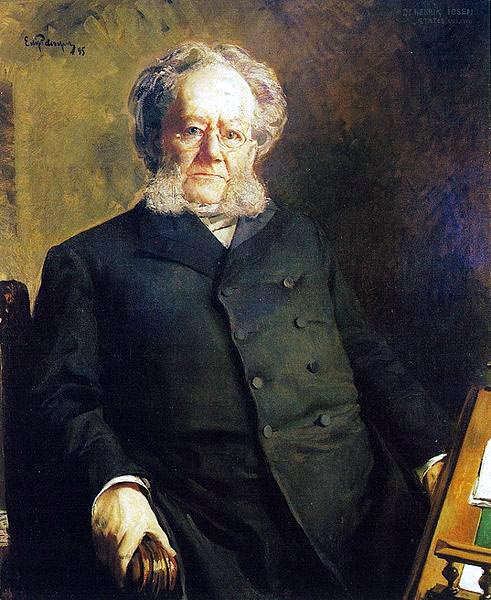 |
| Playwright Henrik Ibsen (Wikipedia) |
Note: Nora craves liberation in a way unsuitable for a woman in 1879. Watch as she gradually breaks out of her "doll's house."
Get Ready: What do you think are the proper roles for a husband and wife--especially if they have children?
A Doll's House (1879) is one of the many remarkable plays written by the 19th-century Norwegian dramatist Henrik Ibsen, said to be the playwright whose works are the most frequently performed after Shakespeare.
As the play begins, Nora Helmer is married to Torvald, a good man, but their lives are locked into traditional roles. She is a housewife, and he the breadwinner who teases her for things like spending too much money on Christmas presents and such. They have three young children.
Three people in the play help us to understand the Helmers' relationship.
Nils Krogstad is an employee of Torvald's at the bank. Torvald has decided that Krogstad must be fired, as he is "morally diseased." Krogstad asks Nora to plead his case with her husband, and reveals that he knows that she has committed a crime. Women at the time were not allowed to conduct financial transactions, so Nora had forged her dead father's name on loan documents to cover the costs of a family trip to Italy (for Torvald, when he was ill). Krogstad will blackmail her if he has to.
Another character is Kristine Linde, Nora's old school friend. She is a widow, and asks Nora to intercede for her with Torvald to give Kristine a job at the bank. Nora asks Kristine to help her convince Krogstad not to follow through with his threat. Instead, Kristine rekindles her relationship with Krogstad, and confesses that she only married her husband for his money. She believes Torvald should know the truth about Nora's activities, in order to strengthen their marriage.
A third player has a less important role. Old Dr. Rank is dying of a terminal illness, and in his last days admits to Nora that he is now and always has been in love with her.
In Act II, Krogstad (who had been fired) had written Torvald a letter telling him what Nora had done. In the third and final act, Torvald reads the letter and laments that he is now entirely in Krogstad's power. He castigates Nora, saying she is immoral and unfit to raise their children.
She is surprised, believing that he would have sacrificed himself to save her. She even thought about killing herself to keep his reputation from being destroyed. But now she realizes that Torvald loves himself more than he loves her.
Another letter arrives from Krogstad, and enclosed is all the incriminating evidence against Nora. Torvald, elated, burns the documents and forgives Nora. But she has had enough. She is tired of being treated like a doll, first by her father and then by her husband. Now she must take care of herself. She leaves behind her keys, her wedding ring, her children, and her crying husband.
Nora's action, of course, was considered scandalous at the time, and in several countries the play could not be performed as written; an alternative ending had to be fashioned for those audiences. Today it is almost always performed with the original ending.
--------Read more: https://en.wikipedia.org/wiki/A_Doll%27s_House
Practice: Match the term to its definition below:
- breadwinner
- castigates
- elated
- forged
- immoral
- incriminating
- intercede (for)
- laments
- scandalous
- terminal illness
- proving a crime has been committed
- signed someone else's name
- shameful; disgraceful
- a sickness leading to death
- overjoyed; happy and excited
- going against society's rules
- one who makes most or all of the household's money
- expresses sorrow
- criticizes severely
- speak on behalf (of)
Answers are in the first comment below.
Submitted to the Shenzhen Daily for August 10, 2021


Answers to the Practice: 1. g; 2. i; 3. e; 4. b; 5. f; 6. a; 7. j; 8. h; 9. c; 10. d
ReplyDelete